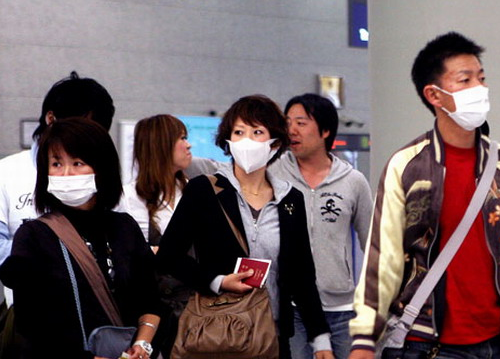
Scientists now estimate that about 280,000 people died in the flu pandemic that swept the globe in 2009 and 2010, more than 15 times the toll that had been officially recorded by laboratory tests of victims.
科學(xué)家現(xiàn)在估計(jì),約有28萬(wàn)人死于2009年和2010年那場(chǎng)席卷全球的流感疫情,是經(jīng)實(shí)驗(yàn)室檢測(cè)確定的官方統(tǒng)計(jì)死亡人數(shù)的15倍還多。
The big increase in estimated deaths from the H1N1 virus isn't a surprise, experts said. In any pandemic, the initial count typically is based on lab-confirmed figures that tend to significantly underestimate the true number of fatalities. In the case of the H1N1 pandemic, there were 18,500 lab-confirmed deaths, while a more comprehensive estimate suggests that anywhere from 151,700 to 575,400 people may have died. The 280,000 figure is a rough median estimate for that range.
專(zhuān)家們說(shuō),他們對(duì)于死于H1N1病毒的估測(cè)死亡人數(shù)大幅增加并不意外。任何一種流行病的初始統(tǒng)計(jì)一般都以實(shí)驗(yàn)室確定的數(shù)據(jù)為基礎(chǔ),而實(shí)驗(yàn)室數(shù)據(jù)往往明顯低于實(shí)際死亡人數(shù)。拿這場(chǎng)H1N1流感來(lái)說(shuō),實(shí)驗(yàn)室證實(shí)的死亡病例為18,500例,而一項(xiàng)更全面的估算顯示,死于該流感的人數(shù)可能在151,700人至575,400人之間。28萬(wàn)是這一估算的粗略中值。
The new study, published in the Lancet, is the first effort to calculate the global impact of the H1N1 virus, known at the time as swine flu. The contagion was triggered by a recombination of bird, pig and human viruses and was the first flu pandemic of the 21st century. The pandemic officially ran from June 2009 to August 2010.
新近發(fā)表在醫(yī)學(xué)雜志《柳葉刀》(Lancet)上的一份研究報(bào)告是估測(cè)這場(chǎng)H1N1流感(當(dāng)時(shí)也被稱(chēng)作“豬流感”)全球影響的首次嘗試。該疫情在禽類(lèi)、豬和人類(lèi)的病毒基因相互結(jié)合后產(chǎn)生,也是21世紀(jì)的首次大流感,官方資料顯示它持續(xù)的時(shí)間為2009年6月至2010年8月。
H1N1 caused havoc around the world, sickening or killing hundreds of thousands of people. It prompted several national public-health emergencies and pushed countries to stockpile vast quantities of vaccine and antiviral drugs.
H1N1流感在全世界造成了嚴(yán)重破壞,數(shù)十萬(wàn)人因此致病或死亡。受其影響,好幾個(gè)國(guó)家啟動(dòng)了全國(guó)性公共衛(wèi)生應(yīng)急機(jī)制,很多國(guó)家不得不儲(chǔ)備大量疫苗和抗病毒藥物。
The latest research confirmed earlier observations that 80% of the pandemic deaths occurred in people younger than 65 years old. About 30% of the victims in that age group were healthy with no underlying risk factors. That is a marked difference from seasonal flu, which mainly claims the elderly and the frail.
這項(xiàng)最新研究證實(shí)了先前的觀察報(bào)告,即在H1N1流感的死亡病例中,有80%都不到65歲,而這一年齡段中的死者又有約30%生前身體健康,沒(méi)有潛在疾患。這是與季節(jié)性流感明顯不同的一點(diǎn)。季節(jié)性流感主要奪去的是年邁體衰者的生命。
The study also found that nearly 60% of the fatalities were likely to have occurred in Southeast Asia and Africa, home to 38% of the global population. The highest mortality rates were in Africa, which suffers from a poor health infrastructure and lack of trained medical personnel.
研究還發(fā)現(xiàn),近60%的死亡病例可能出現(xiàn)在東南亞和非洲,這兩地的人口占全球總?cè)丝诘?8%。其中,非洲的死亡率最高,那里醫(yī)療設(shè)施薄弱,缺乏訓(xùn)練有素的醫(yī)務(wù)人員。
"The number of deaths is not the only thing to look at in assessing the impact, but the huge loss of human potential," said Fatimah Dawood, an epidemiologist and pediatrician at the U.S. Centers for Disease Control and Prevention in Atlanta, who was lead author of the paper. Because of the many younger H1N1 victims, she added, "more than three times the number of years [of life] were lost than are lost in a seasonal flu epidemic."
美國(guó)疾病控制與預(yù)防中心(U.S. Centers for Disease Control and Prevention)的流行病學(xué)家兼兒科醫(yī)生達(dá)伍德(Fatimah Dawood)說(shuō),死亡人數(shù)不是評(píng)估疫情影響時(shí)唯一要關(guān)注的因素,還要看到疫情給人類(lèi)潛力造成的巨大損失。達(dá)伍德是這份研究報(bào)告的主要作者。她說(shuō),H1N1流感導(dǎo)致很多較年輕的人死亡,這一流感奪去的人類(lèi)壽命是季節(jié)性流感所奪去人類(lèi)壽命的三倍還多。


